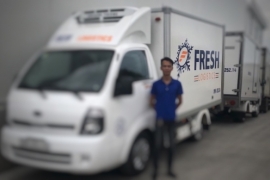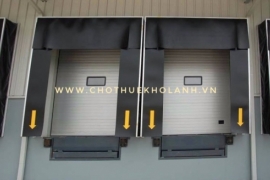TRANSPORTING BY REFRIGERATED CONTAINERS IN LOGISTICS
The widespread application of refrigerated containers in freight transport, import and export, ... over the past years has improved logistics efficiency, reduced costs, and created strong impacts on the freight transport industry in Vietnam.
Refrigerated containers: Definition and benefits
Refrigerated container (or Reefer) is one of the 6 types of freight containers used in the transportation and logistics industry. They look no different from the ordinary containers when viewed from the outside, but when you look closely at the features and construction, this "giant metal box" is similar to a large refrigerator that can control and maintain the temperature of goods.
With the range of sizes from 20 feet (standard) up to 50 feet, this "giant" can store a large amount of goods many times larger than other vehicles (such as styrofoam boxes, refrigerators, refrigerated trucks). Refrigerated containers are considered the same as a movable mini cold storage. With high flexibility, they can be placed on tractors, seaports, trains for transportation.
Refrigerated containers are transported on tractors
Since refrigerated containers were first introduced and used in the logistics industry in 1960, they have revolutionized the way of shipping all over the world. Instead of using traditional refrigerated transport methods which are expensive and easy to damage goods during delivery and receipt, refrigerated containers have brought "a wind of change" when controlling and keeping the temperature more stable. Using refrigerated containers not only helps to improve and optimize costs in the logistics industry but also increases the commercialization of frozen goods, especially when transporting via sea (import and export).
Improve and optimize costs when shipping via sea
For enterprises specialize in transportation, import and export, and logistics, processing and preserving perishable goods by refrigerated containers is an indispensable step in the domestic and foreign supply chains. Nam Ha Noi Cold Storage - a strategic partner of many businesses will help you to get the information related to refrigerated containers so that you can apply them more effectively to your business.
Things to keep in mind when using refrigerated containers
Before transporting any type of goods by refrigerated containers, businesses need to understand the how they work as follows:
- The temperature inside the refrigerated containers can be maintained from -35°C to +35°C (there are many types up to -60° to - 40°C) without being affected by external factors.
- Is there air circulation in the refrigerated containers? The answer is YES because in order to maintain the temperature of the goods inside the enclosed space, refrigerated containers are required to be specially designed (T-floor) so that the air can properly circulate over the entire shipment.
- This tool has the ability to increase and lower the inside temperature when needed and it is adjusted by the refrigeration system mounted at the back of the container.
- The control unit on the container allows setting and adjusting parameters such as temperature, humidity, ventilation and air inside the trunk. These parameters will also be adjusted and changed depending on the type of goods to be transported. Controlling these factors allows goods to stay fresh longer with more consistent quality.
- The source of energy (electricity) supplied to the refrigerated containers must always be continuous.
- Refrigerated containers are only capable of maintaining the available temperature of goods. They are not as effective as food freezing system.
- Refrigerated containers can be used to transport dry, cool and frozen goods, not necessarily frozen food.
- Do not load goods beyond the container mark: There is a mark inside each refrigerated container regulating that the height of goods to be loaded in the trunk must not exceed this mark. This ensures air circulation from the end to front space of the container and keeps the entire container at a “blue” temperature.
- It is not necessary to use a separation layer (plastic or foam packaging) between the goods and the container shell because the special structure of the container floor can ensure air circulation to every corner of the container.
- Temperature recording: There is a machine in the container’s cooling system that monitors the operation of the container as well as the temperature level inside it. This helps the transporters to monitor the container during transportation. In addition, it is also a basis for determining liability in case the goods are damaged.
Parameters on refrigerated containers
In addition, you can get more information about the specifications of the container when looking at the parameter system written on the container shell (on the door). These types of symbols/codes represent different meanings in compliance with the current standard that regulates container symbols and codes ISO 6346:1995. Accordingly, these marks are divided into the following main categories:
- Identification system.
- Size and type codes.
- Operational markings.
In order for readers to have a more accurate imagination, Nam Ha Noi Cold Storage will show the parameters on the container in the following image:
After understand the operating principle and parameters on the container, let's come to the arranging principles of goods.
How to determine cargo temperature and adjust on containers
To determine the correct temperature for your items, consider the following points:
- Each type of goods has a different storage temperature. For example, the storage temperature of ripe bananas is from 14°C to 16°C and pork is -18°C. For goods to be delivered safely and securely, determine the product storage temperature (indicated on the package) and adjust the container temperature accordingly.
- Calculate the travel distance and conditions along the transportation route to make the best temperature adjustment. During the packing process, it is necessary to monitor the operation of the container at least every 3 hours to ensure that the container operates normally and always maintaining the required temperature.
- Temperature monitoring systems are available at all times to ensure refrigerated containers are working properly during transportation and all cargoes are being stored at the correct temperature. If you are unsure of how to operate a refrigeration container, read the instruction manual or contact the manufacturer for further instructions.
Improve the transportation capacity of Vietnamese enterprises with refrigerated containers combined with cold storages
Currently, limited storage space and weak freight transport capacity are one of the major challenges of the cold chain in Vietnam. Vietnamese enterprises encounter many difficulties because the infrastructure (including cold storages and refrigerated containers) is inadequate and inconsistent, leading to high logistics costs while the quality of goods is not guaranteed.
Refrigerated containers cost 1.5 times more than other standard containers. In return, this tool possesses many practical features such as large storage space (20 feet to 50 feet), stackable (like pallets) and especially, they can transport huge volumes of cargoes that airplanes or trucks cannot compare. However, the use of refrigerated containers in some businesses today has not yielded the expected results. The main reason is that they consider refrigerated containers as a place to freeze and cool products. However, as Nam Ha Noi Cold Storage mentioned in part I, refrigerated containers can only maintain temperature without the function of freezing and cooling products. So, goods will most likely be damaged and significantly reduced the quality if they are not refrigerated (freeze food) at the cold storage before.
According to a statistic, most of the exported fruits harvested at the barns and farms are directly packed and placed in refrigerated containers without being cooled properly (achieved the ideal storage temperature). This results in quick deterioration and quality reduction of goods. To properly freeze products, a cold storage is required to cool the product before packaging and shipping.
To improve transportation capacity and make the best use of refrigerated containers, businesses need to closely combine with freezing to minimize losses and not affecting the product quality.
Hopefully, Nam Ha Noi Cold Storage has partly helped you to gain more useful information to apply in your business with the above sharing.
Nam Ha Noi cold storage has been striving to become one of the companies providing cold storage rental services combined with quality cold transport, satisfying the needs of customers and contributing to the establishment of the most modern closed supply chain.
With the goal of creating a different, convenient and optimal cold storage service beyond customers’ expectation, our services will make the job simpler and faster.
Visit our Fanpage or hotline 0772.84.9999 for more information about Nam Ha Noi Cold Storage.







